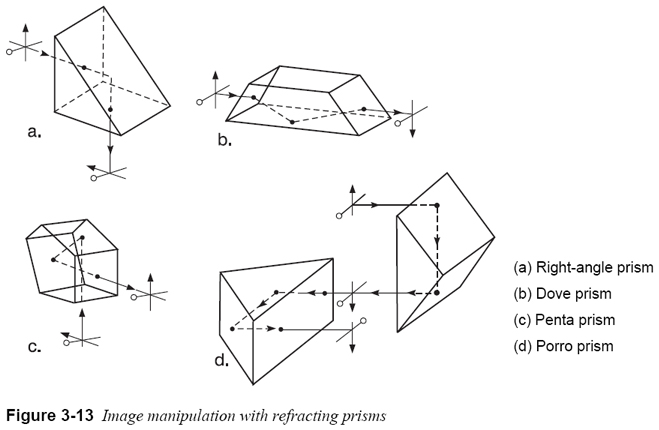3. Special applications of prisms. Prisms that depend on total internal reflection are commonly used in optical systems, both to change direction of light travel and to change the orientation of an image. While mirrors can be used to achieve similar ends, the reflecting faces of a prism are easier to keep free of contamination and the process of total internal reflection is capable of higher reflectivity. Some common prisms in use today are shown in Figure 3-13, with details of light redirection and image reorientation shown for each one. If, for example, the Dove prism in Figure 3-13b is rotated about its long axis, the image will also be rotated. 
The Porro prism, consisting of two right-angle prisms, is used in binoculars, for example, to produce erect final images and, at the same time, permit the distance between the object-viewing lenses to be greater than the normal eye-to-eye distance, thereby enhancing the stereoscopic effect produced by ordinary binocular vision.
II. IMAGE FORMATION WITH MIRRORS
Mirrors, of course, are everywhere—in homes, auto headlamps, astronomical telescopes, and laser cavities, and many other places. Plane and spherical mirrors are used to form three-dimensional images of three-dimensional objects. If the size, orientation, and location of an object relative to a mirror are known, the law of reflection and ray tracing can be used to locate the image graphically. Appropriate mathematical formulas can also be used to calculate the locations and sizes of the images formed by mirrors. In this section we shall use both graphical ray tracing and formulas.
Page: 12345678910111213141516171819202122232425262728293031323334353637383940
| Eyes carePhysicianBate's booksTechnologyForumLaser corre.Blues under eyesburning in the eyesanother diseasesMedical mistery Naturally eyesight correction. No laser eye surgery. Restore eyesight. Vision correction. https://countertopscolumbia.com choose between tile or a kitchen slab granite. | |




